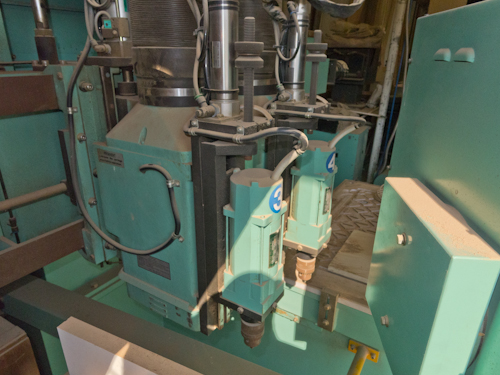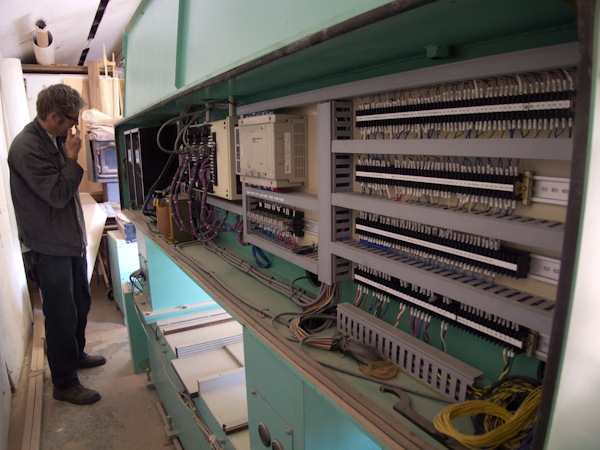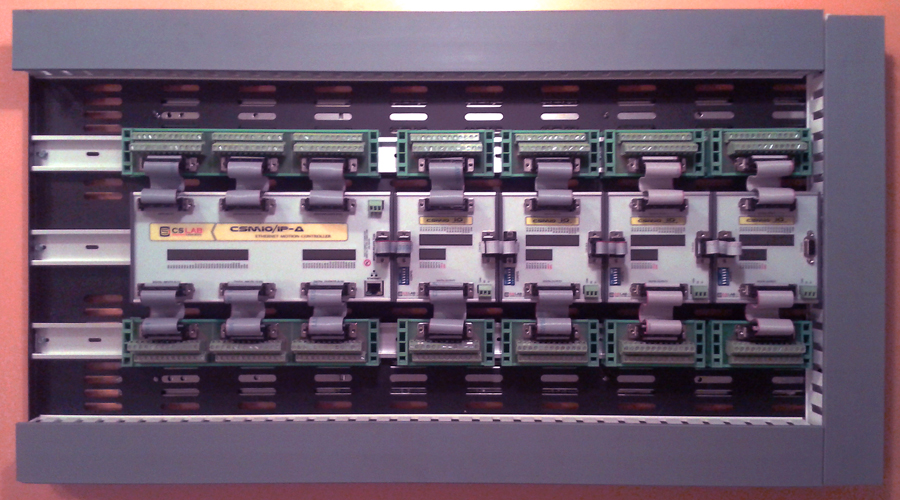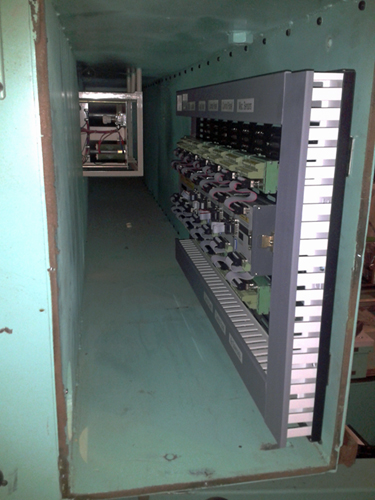While this is going to be somewhat of a project type thread, I think it may serve best being here in the CSMIO forum since it will pretty much encompass specifically how these controllers can be used in a retrofit. I don't plan to cover much in terms of the machine itself, other than how the CSMIO is used to accomplish various tasks needed in the machine. Hopefully, others will agree that this is a good place for this topic.
First, this is not my first commercial CNC router and I've had experience with several over the years. I bought an SCM Routomat sometime around 2003 and had some exposure to them prior to that as well, all the way back into the early 90's when working at Gibson Guitar in Bozeman, MT. If I remember right, they were using a Fadal at the time, so not a CNC router so much as a machining center. Never the less, I found the machine and all the hand coding that was done to be fascinating. I sold my woodshop a while back, just before the market tanked, and have taken some time off from woodworking since then, spending it with my kids while they are still young. Over the last year, I started considering getting back into the business and focus solely on CNC work. To get started, I wanted a machine that was industrial, but also would fit in my 24x24 ft garage so I could start out working at home and see where it goes this time around. I found a 1991 Shinx CNC router with a 4ft by 4ft work area, twin router heads, each with a piggy back drill, that can be spaced at various OCs for multi-part simultaneous cutting. The price was right and the terms even better, so I went for it. I think I got it for less than it's scrap price, though it does weigh about 8000lbs (used a 15,000 lb lift to get it in the garage!). It takes up about 12 feet across the gantry including the motor, and about 10 feet front to back. It just fit under my 8 ft ceilings by about half an inch, but only after I removed the pneumatic dust collection rams. Some photos of the machine:
![]()
![]()
![]()
The bad news was that the controller was non-operational (the price reflected this, so not a deal breaker). After checking it over, I found the PC, which was not a normal off the shelf variety, seemed to be having trouble reading the system disc. The entire CNC ran off of a 3 1/2 inch floppy, and there was no hard drive in the unit, just 640K of RAM. I found a guy that was very good with vintage computers, and he basically just laughed when I asked if it could be repaired. He did confirm that the problem was in the PC itself, rather than the drive, or any other easily replace peripheral. At that point, it seemed like a waste of time to continue trying to do a quick fix, so I started researching the latest crop of controllers.
When I had last owned a machine, the only things available that could run an industrial machine reliably and integrate with the analog servos were either very expensive, or very hard to figure out how to configure properly. Centroid controllers were at the top of my list then, so that's where I started looking. I don't remember Mach being a serious alternative for large and complicated machines at the time, so I had pretty much dismissed it. I have to say that I'm surprised what has transpired in the last 6 years or so. I was surprised to find that there are multiple candidates for this retrofit and had given consideration to Vital Systems dspMC/IP and Dynomotion KFLOP, both of which could use the servos the machine already has. I won't go into specifics about why I chose CS Labs over those products, but the main reason is that I like the modular expandability and the overall design of how the product lays out. I think it has a leg up on anything right now in terms of providing a clean installation layout and has all the features that I need. Mainly, I needed a ton of I/O connections as I plan to maintain the original control panel with LED indicators; and I needed analog control of my servos with a closed loop system. The CSMIO IP-A covers those needs at a price that is extremely competitive, particularly once you compare like numbers of I/Os.
I ordered and received my controller and I/O modules in under a week, all the way from Poland to Seattle. Right away, I started working on figuring out how to integrate the new controller with my machine and had a great deal of good fortune. I bought a server rack vent panel, which is made of some reasonably heavy stamped steel with half inch sides bent from the face to make a rigid panel. This was $10 at the local PC recycling shop, along with another $10 for a pair of full extension server drawer slides. This combination appeared to be enough to get most of the panel out of the machine for servicing/installing, while allowing it to slide completely into the machine during use. I had some spare Panduit channels laying around, so all I needed was some covers (which I bought at the local industrial supply) and some DIN rail. Here's the finished assembly, though the controller and I/O modules are in a somewhat random position at this point:
![]()
After drilling and tapping some 10-24 holes for mounting the server slides, this is the resulting installation to this point:
![]()
![]()
The original controller was located in the same location, and since there is so much room in the gantry, it seemed it would be a shame to waste it. Plus, there is a fan at the other end of the gantry tunnel, and a filtered cover that will go over the open end which I'll eventually make into a operating door. The panel is about 17.5" tall and 32" long, so that may give some scale to the photos. The servo power supply is about two and a half feet farther into the tunnel than the end of the panel, but since the original controller didn't have any problems, I'm not expecting that it will be an issue now either. The gantry is somewhat of an "H" beam, though welded that way, with a closed front face. It's made of just under 1/2" plate steel, and there is already a 3-4" hole cute through the center plate for wiring (thank God, I would not have wanted to deal with drilling a hole through that!). I plan to run wire from the top inner most corner around the outside and out the lower inner corner of the Panduit channel. The wiring will run through the hole, which is near the opening, and when you pull the panel out it should have slack built in to allow the motion.
Hopefully I'll have some more progress by next weekend, and some better quality photos.
First, this is not my first commercial CNC router and I've had experience with several over the years. I bought an SCM Routomat sometime around 2003 and had some exposure to them prior to that as well, all the way back into the early 90's when working at Gibson Guitar in Bozeman, MT. If I remember right, they were using a Fadal at the time, so not a CNC router so much as a machining center. Never the less, I found the machine and all the hand coding that was done to be fascinating. I sold my woodshop a while back, just before the market tanked, and have taken some time off from woodworking since then, spending it with my kids while they are still young. Over the last year, I started considering getting back into the business and focus solely on CNC work. To get started, I wanted a machine that was industrial, but also would fit in my 24x24 ft garage so I could start out working at home and see where it goes this time around. I found a 1991 Shinx CNC router with a 4ft by 4ft work area, twin router heads, each with a piggy back drill, that can be spaced at various OCs for multi-part simultaneous cutting. The price was right and the terms even better, so I went for it. I think I got it for less than it's scrap price, though it does weigh about 8000lbs (used a 15,000 lb lift to get it in the garage!). It takes up about 12 feet across the gantry including the motor, and about 10 feet front to back. It just fit under my 8 ft ceilings by about half an inch, but only after I removed the pneumatic dust collection rams. Some photos of the machine:



The bad news was that the controller was non-operational (the price reflected this, so not a deal breaker). After checking it over, I found the PC, which was not a normal off the shelf variety, seemed to be having trouble reading the system disc. The entire CNC ran off of a 3 1/2 inch floppy, and there was no hard drive in the unit, just 640K of RAM. I found a guy that was very good with vintage computers, and he basically just laughed when I asked if it could be repaired. He did confirm that the problem was in the PC itself, rather than the drive, or any other easily replace peripheral. At that point, it seemed like a waste of time to continue trying to do a quick fix, so I started researching the latest crop of controllers.
When I had last owned a machine, the only things available that could run an industrial machine reliably and integrate with the analog servos were either very expensive, or very hard to figure out how to configure properly. Centroid controllers were at the top of my list then, so that's where I started looking. I don't remember Mach being a serious alternative for large and complicated machines at the time, so I had pretty much dismissed it. I have to say that I'm surprised what has transpired in the last 6 years or so. I was surprised to find that there are multiple candidates for this retrofit and had given consideration to Vital Systems dspMC/IP and Dynomotion KFLOP, both of which could use the servos the machine already has. I won't go into specifics about why I chose CS Labs over those products, but the main reason is that I like the modular expandability and the overall design of how the product lays out. I think it has a leg up on anything right now in terms of providing a clean installation layout and has all the features that I need. Mainly, I needed a ton of I/O connections as I plan to maintain the original control panel with LED indicators; and I needed analog control of my servos with a closed loop system. The CSMIO IP-A covers those needs at a price that is extremely competitive, particularly once you compare like numbers of I/Os.
I ordered and received my controller and I/O modules in under a week, all the way from Poland to Seattle. Right away, I started working on figuring out how to integrate the new controller with my machine and had a great deal of good fortune. I bought a server rack vent panel, which is made of some reasonably heavy stamped steel with half inch sides bent from the face to make a rigid panel. This was $10 at the local PC recycling shop, along with another $10 for a pair of full extension server drawer slides. This combination appeared to be enough to get most of the panel out of the machine for servicing/installing, while allowing it to slide completely into the machine during use. I had some spare Panduit channels laying around, so all I needed was some covers (which I bought at the local industrial supply) and some DIN rail. Here's the finished assembly, though the controller and I/O modules are in a somewhat random position at this point:

After drilling and tapping some 10-24 holes for mounting the server slides, this is the resulting installation to this point:


The original controller was located in the same location, and since there is so much room in the gantry, it seemed it would be a shame to waste it. Plus, there is a fan at the other end of the gantry tunnel, and a filtered cover that will go over the open end which I'll eventually make into a operating door. The panel is about 17.5" tall and 32" long, so that may give some scale to the photos. The servo power supply is about two and a half feet farther into the tunnel than the end of the panel, but since the original controller didn't have any problems, I'm not expecting that it will be an issue now either. The gantry is somewhat of an "H" beam, though welded that way, with a closed front face. It's made of just under 1/2" plate steel, and there is already a 3-4" hole cute through the center plate for wiring (thank God, I would not have wanted to deal with drilling a hole through that!). I plan to run wire from the top inner most corner around the outside and out the lower inner corner of the Panduit channel. The wiring will run through the hole, which is near the opening, and when you pull the panel out it should have slack built in to allow the motion.
Hopefully I'll have some more progress by next weekend, and some better quality photos.